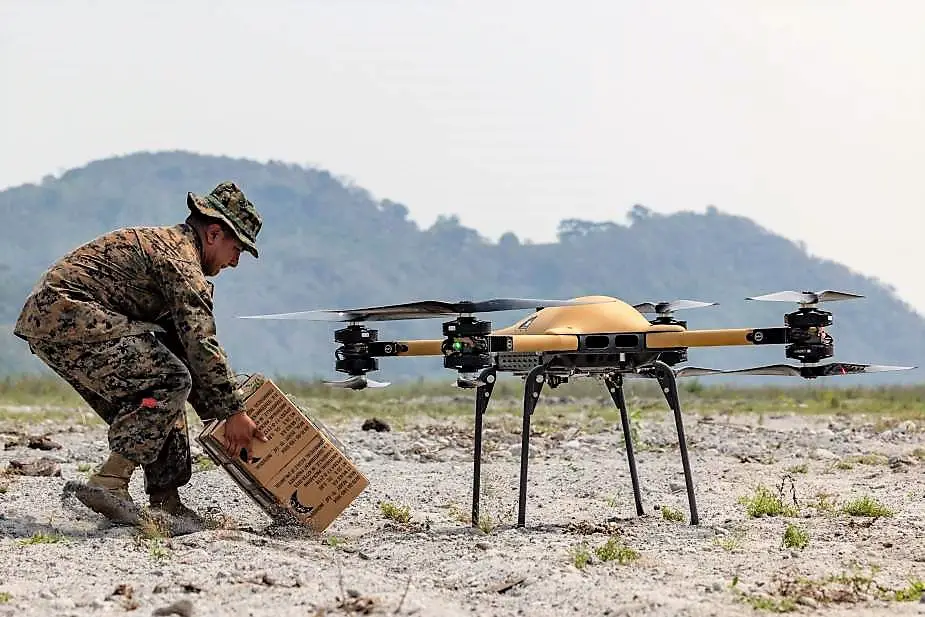“The Marine Corps requires unmanned air, surface, and ground systems to fully exploit our inherent expeditionary nature and capabilities. When operating forward, in small groups, under austere conditions, the ability to maximize unmanned systems to create outsized effects for our allies and against our adversaries is a key element of our future success.” - Gen. Berger, Commandant of the Marine Corps.
Follow Army Recognition on Google News at this link

U.S. Marine Corps Cpl. Mark Bernal, a landing support specialist with 3d Littoral Logistics Battalion, 3d Marine Littoral Regiment, 3d Marine Division, receives a package from a TRV-50 Tactical Resupply UAS as it lands to resupply U.S. Marines in the field during Balikatan 23 in Cerab, Philippines, April 21, 2023 (Picture source: USMC:Cpl. Tyler Andrews)
According to Maj. Keenan Chirhart of the U.S. Marine Corps Combat Development Command, the United States has maintained its global dominance by capitalizing on its strong economy and robust industrial base, which have facilitated the development of advanced combat systems. However, the decreasing cost of technology and the availability of asymmetric equipment in the commercial market have necessitated new approaches to leverage technological growth. The U.S. military must adapt by incorporating innovative warfighting techniques to counter increasingly technologically advanced adversaries.
Currently, the Marine Corps is at the forefront of developing and integrating emerging technologies. Intelligent Robotics and Autonomous Systems (IRAS), combined with effective combined arms doctrine, significantly enhance situational awareness across all levels of warfare. Through all-domain sensors detecting enemy activity and providing real-time targeting data over long distances, the battlefield becomes more transparent for individual Marines and the chain of command. This enables rapid coordination of sensors, weapons, and decision-makers to effectively engage and neutralize the enemy.
However, the abundance of information in the combat environment poses cognitive challenges, overwhelming commanders in their decision-making process. On the other hand, this information abundance also creates opportunities. The forces that can process information rapidly and effectively gain a distinct advantage. Artificial intelligence and machine learning software developments alleviate the cognitive burden by organizing data logically and prioritizing it. Marines can make sense of the information and act swiftly, disrupting the adversary's targeting and decision cycle, enhancing survivability, and expediting movement and maneuver. Ultimately, the combination of Marine decision-makers with IRAS creates an unparalleled tempo that outmatches the enemy.
As adversaries employ anti-access/area denial systems, sustaining U.S. operating forces within the enemy weapons engagement zone becomes a significant logistical challenge. The physical burden on Marines, carrying excessive supplies and ammunition, hinders their ability to maneuver quickly and exposes them to risk. IRAS can alleviate this burden by lightening the Marines' load, expediting supply staging and transfer across vast maritime distances. Utilizing various air, land, and surface logistical connector vehicles allows for ship-to-shore sustainment of maneuvering units while reducing risks associated with traditional manned resupply aircraft.
To fully capitalize on the benefits of IRAS, these systems must operate through networked and collaborative autonomy. By integrating data from distributed platforms and utilizing common mission controllers, individual warfighters gain the ability to control multiple platforms and payloads to accomplish their mission. The Marine Corps is working closely with industry partners and research agencies to develop vehicles capable of conducting swarming maneuvers and attacks. These swarming vehicles leverage multiple systems to sense each other, process information rapidly, and execute kinetic effects with maximum efficiency. This technology reduces the number of munitions required to achieve strategic effects, further decreasing the logistics burden.
Referring to these capabilities as "unmanned" is an incomplete description. While that term was commonly used, it is important to acknowledge the essential role of humans in warfighting. Successful employment of IRAS relies on human oversight and interaction. Additionally, IRAS systems are designed to be interoperable, modular, and secure, facilitating streamlined training and proficiency while reducing costs, training time, and manpower requirements.
As the threat landscape and operating environments continue to evolve, the future remains uncertain. If technology continues its exponential growth, future Marines may be equipped with physical augmentations and hybrid virtual reality optics. Legacy manned aircraft and IRAS fighter jets may work in tandem, enhancing survivability and optimizing their signatures. Weaponized IRAS aircraft could utilize predictive modeling to engage and neutralize enemy formations before they can even react.
While the Marine Corps possesses ambition and creativity, it actively explores technologies that could one day transform its aspirations into reality. By harnessing the rapid advancement of Integrated Responsive Adaptive Systems (IRAS) and aligning them with innovative warfighting concepts, Marines will gain the ability to operate in dispersed environments. These systems will be cost-effective, enduring, and adept at managing their signatures. As the nature of threats evolves, future Marines will need to adapt their combat approaches and commanders must foster confidence in IRAS to ensure their units maintain a tactical edge and achieve maximum effectiveness. Additionally, leaders at all levels must establish effective feedback channels to comprehend the evolving requirements of warfighters and provide them with the latest IRAS tools to effectively detect, engage, and eliminate enemy forces.
Defense News June 2023















